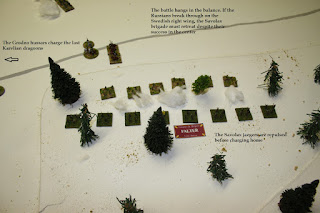 |
| Johan Adam Cronstedt |
 |
| The map of the battle. |
Prior to the game in this article we visited the site of the battle as it's close to my home. It's July so there's no ice or snow even if it is the coldest summer in decades here. Still, viewing the battlefield gave us some insight into the scale of the battle and the position the troops were in:
 |
| The woods at the site of the jaeger skirmish |
 |
| Can't draw a very effective LOS here :) |
The pastor of the infantry regiment, Carl Johan Holm complains in his memoirs that the brigade was in a good position to whip the Russians and that Cronstedt had been too timid to take advantage of this situation. This leads to our refight as we're about to see if Holm was right!
 |
| The portion of the map our 6x4 table covers. One centimeter on the table equals about ten meters. |
Commentary is embedded in the images:
So the Savolax Brigade was victorious, inflicting three or four times as many casualties to their enemy than which they received! Our meticulously realistic military simulation clearly proves that had the Savonians attacked that day, they would have been victorious. There is just one big BUT. This was just the Russian VANGUARD. Cronstedt was facing an army twice as big as his brigade. Cronstedt was guarding the backdoor route into Oulu right behind the Swedish main army. If he would have defeated the Russians at Leppävirta there would have been more of them and the Savolax brigade did not have positions where they could stop the Russians entirely. If the brigade would become worn in battle or lose, they could not protect the Swedish rear effectively, simple as that. It shows us that people such as Holm are quick to complain about the tactical situation while ignoring the strategic situation. Cronstedt was right to play it safe in order to fulfill his strategic goals.
As for the the game, as you can see, jaegers are prominent and important in the Finnish War because the terrain is so congested and the forces small. The rules we use therefore need good skirmishing rules and General de Brigade seems to fit the bill, even if the system is showing it's age with all the charts and the modifiers. A lot of the Napoleonic rules out there are focused on a grander scale and leave skirmishing as a footnote. I also like the orders system in GdB.
I don't have closeups on the models I painted for you yet. I hoped to do this the other way around, presenting the game after showing off the new models, but I want to finish two more stands of Savonian infantry before photographing the brigade. As for gaming, I think we will play the battles of Siikajoki and Revolax next so that we have the winter of 1808 covered after that.
PS: When speaking about the Finnish war (or the Russo-Swedish war of 1808-1809) I will often refer to armies composed almost entirely of ethnic Finns as Swedish because for all intents and purposes, Finland was part of Sweden during that time and Finns fought in the Swedish army. Most of the units engaged during the war were Finns commanded by Swedish officers. The soldier would speak Finnish among themselves, but orders rang out in Swedish. I hope that helps any "outsiders" understand the nature of the army.


















